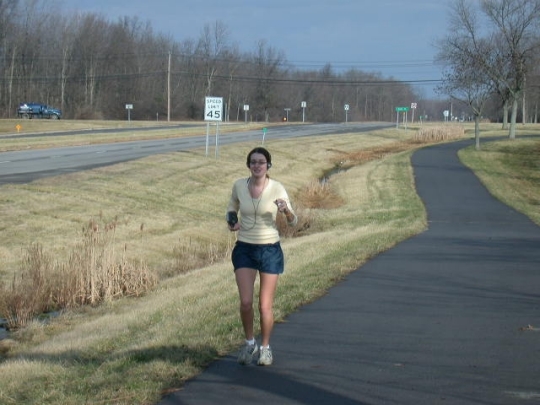Most people think that running means being constantly out of breath. Most beginners contribute to this misconception because, believe it or not, they run too fast. They think that running is always supposed to be hard work, so the more difficult it feels, the more correctly they’re doing it, and the more they’re benefiting; but that’s not the case. Most runners should run at a relaxed, moderate pace just this side of being out of breath for most of their running sessions. That’s certainly always been the case for me, even when I was training to be the best in the world. At this pace, you train, but don’t strain. You’re providing that slight stress to your body that’s going to prompt it to get stronger, but you’re running within yourself rather than going all out.
How do you know what this pace is? In scientific terms, it corresponds to getting your heart rate up to about 70 percent of its maximum. Of course, most runners, especially most beginners, don’t know what these figures are to begin with, much less use them for training. But that’s not a problem.
You don’t need a battery of tests and a heart rate monitor to find your optimal training pace; you don’t even need to check how fast per mile you’re running. All you need to do is strike up a conversation. When you can do so while running, but still feel as though you’re putting in a solid effort, you’re training at the right pace. This is known as passing the talk test.
Passing the talk test means that you should be able to speak in complete sentences while you’re running at a moderate training level. If you can only offer one-word grunts in response to another runner’s questions, then you’re going too fast for how hard you should be running during the first few months of your running program. As I said, this is the level of effort that I maintain on most of my runs. (The exceptions are when I’ve planned to do some running at race pace or faster to prepare for competition.) The next time you see a group of experienced runners, watch closely. I bet you that you’re more than likely to see them carrying on a conversation, even at what might appear to be a startlingly quick pace. You should follow their example. On the other hand, if you can reel off a soliloquy from Hamlet without breaking stride, you might want to pick it up a bit.
Going too fast might seem like a good way to get past a more moderate progression, but you can’t trick your body into getting fitter than it’s ready to. When you run too fast, you’re not going to be able to extend your distance as easily; when you’re starting out, it’s how far you can run, not how fast, that’s more important in building your endurance. Also, when you run too hard all the time, you’re more likely to get injured, and you’re less likely to enjoy your running and want to stick with it. Of course, a lot of beginners don’t always have someone to run with, so it’s tough to know if they can pass the talk test. After all, you’re probably self-conscious enough as it is when you start a running program; you don’t need to have your neighbors see you trotting down the street carrying on a conversation with yourself to add to things. An alternative to the talk test is to check to see whether you can hum a familiar tune to yourself for a line or two at a time.
Another good way to gauge your effort is by judging it against a scale called rating of perceived effort. Research has shown that once runners learn the scale, they can accurately say where they are on it. Here’s one version of the scale:
Rating Perception of effort
0 Nothing at all
0.5 Very, very weak (just noticeable)
Rating Perception of effort
1 Very weak
2 Weak
3 Moderate
4 Somewhat strong
5 Strong
6 Strong
7 Very strong
8 Very strong
9 Very strong
10 Very, very strong (almost maximal)
>10 Maximal
When you’re gradually building your endurance, you should be in the 3 to 4 range. That’s a similar level of effort to being able to pass the talk test.
 This blog contains more than 100,000 words. That’s a lot of writing! How do you go about tackling such a big project? You set intermediate goals and then set short-term goals to get you to those intermediate goals. You track your progress toward these shortterm goals, all the while reminding yourself of the long-term goal, and when necessary and appropriate, you review what you’ve done to remind yourself how far you’ve come. That’s the approach that I recommend for running as well. You need to set both shortterm and long-term goals, you need a way to track those goals, and you need to monitor how you’re progressing toward your goals, both to see whether they need to be revised and to remind yourself how far you’ve come.
This blog contains more than 100,000 words. That’s a lot of writing! How do you go about tackling such a big project? You set intermediate goals and then set short-term goals to get you to those intermediate goals. You track your progress toward these shortterm goals, all the while reminding yourself of the long-term goal, and when necessary and appropriate, you review what you’ve done to remind yourself how far you’ve come. That’s the approach that I recommend for running as well. You need to set both shortterm and long-term goals, you need a way to track those goals, and you need to monitor how you’re progressing toward your goals, both to see whether they need to be revised and to remind yourself how far you’ve come.




 A
A






 The most common place to run, and usually the most convenient, is the road. Most people can just step outside of their homes, hit the road, and be off on an infinite number of routes.
The most common place to run, and usually the most convenient, is the road. Most people can just step outside of their homes, hit the road, and be off on an infinite number of routes.
